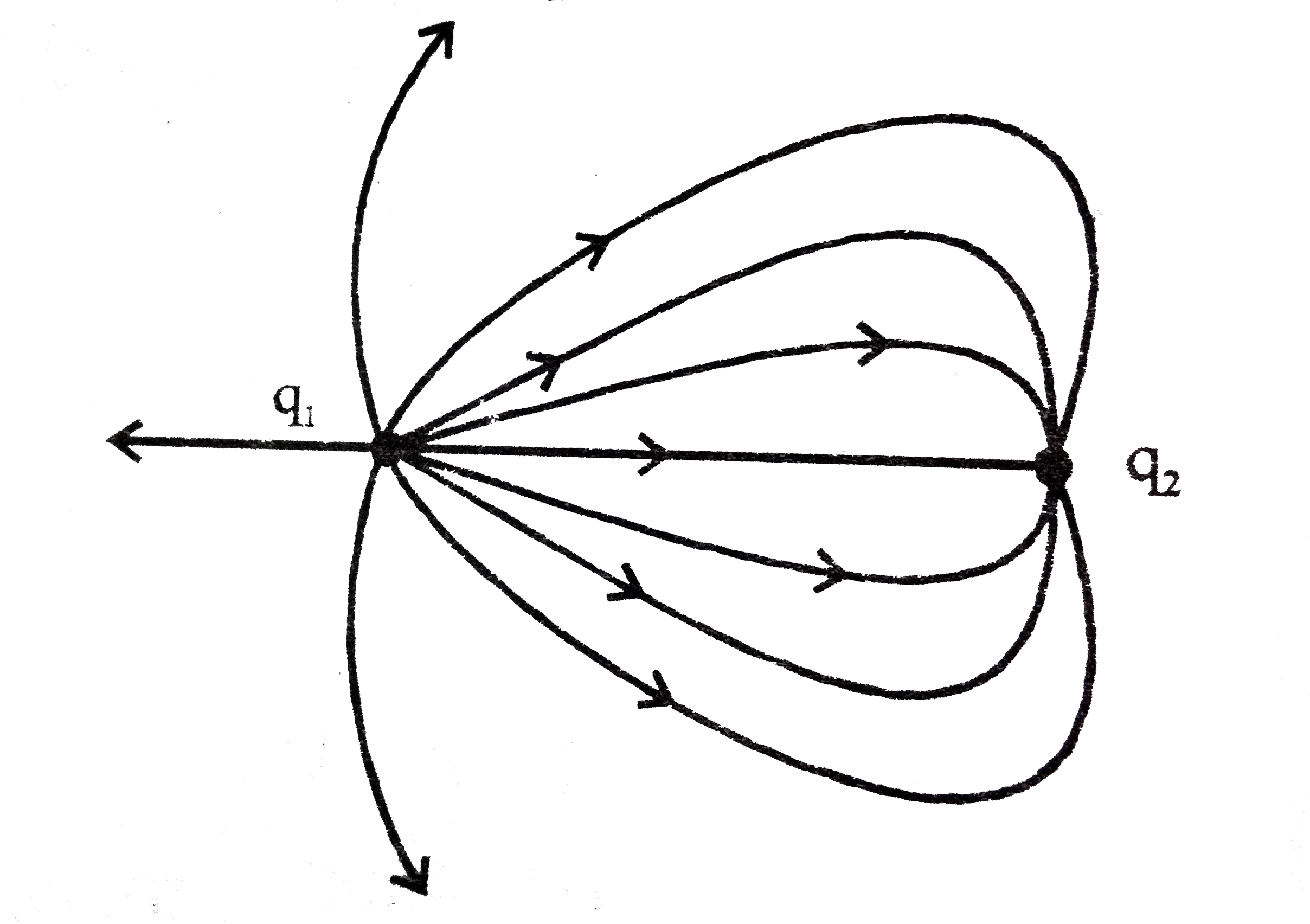Draw the electric field lines due to two equal and opposite point charges.
To draw the electric field lines due to two equal and opposite point charges, follow these steps:
1. Identify the Charges:
- Consider two point charges: one positive charge (+q) and one negative charge (-q). Place them at a distance apart from each other.
2. Draw the Charges:
- On your paper, represent the positive charge with a plus sign (+) and the negative charge with a minus sign (−). For example, place +q on the left and -q on the right.
3. Determine the Direction of Electric Field Lines:
- Electric field lines originate from the positive charge and terminate at the negative charge. This means that the lines will start from the +q charge and point towards the -q charge.
4. Draw the Electric Field Lines:
- Begin by drawing several lines starting from the positive charge. These lines should curve outward and then bend towards the negative charge. Ensure that the lines are drawn in such a way that they show the attraction between the positive and negative charges.
5. Ensure Symmetry:
- Since the magnitudes of the charges are equal, the number of electric field lines emanating from the positive charge should be equal to the number of lines terminating at the negative charge. This indicates that the electric field strength is the same in both regions.
6. Label the Diagram:
- Clearly label the positive charge (+q) and the negative charge (-q) on your diagram. You may also label the electric field lines with arrows indicating the direction of the field (from +q to -q).
Final Diagram:
- Your final diagram should show a positive charge on the left with several lines radiating outwards and curving towards the negative charge on the right. The lines should not cross each other and should be denser near the charges, indicating a stronger electric field in those regions.
- Consider two point charges: one positive charge (+q) and one negative charge (-q). Place them at a distance apart from each other.
- On your paper, represent the positive charge with a plus sign (+) and the negative charge with a minus sign (−). For example, place +q on the left and -q on the right.
- Electric field lines originate from the positive charge and terminate at the negative charge. This means that the lines will start from the +q charge and point towards the -q charge.
- Begin by drawing several lines starting from the positive charge. These lines should curve outward and then bend towards the negative charge. Ensure that the lines are drawn in such a way that they show the attraction between the positive and negative charges.
- Since the magnitudes of the charges are equal, the number of electric field lines emanating from the positive charge should be equal to the number of lines terminating at the negative charge. This indicates that the electric field strength is the same in both regions.
- Clearly label the positive charge (+q) and the negative charge (-q) on your diagram. You may also label the electric field lines with arrows indicating the direction of the field (from +q to -q).
- Your final diagram should show a positive charge on the left with several lines radiating outwards and curving towards the negative charge on the right. The lines should not cross each other and should be denser near the charges, indicating a stronger electric field in those regions.
Topper's Solved these Questions
- STATIC ELECTRICITYBOOK - CENGAGE PHYSICSCHAPTER - STATIC ELECTRICITYEXERCISE - MANDATORY EXERCISE (Exercise Set I) Multiple Choice Questions with One Correct Answer
13 Videos
- STATIC ELECTRICITYBOOK - CENGAGE PHYSICSCHAPTER - STATIC ELECTRICITYEXERCISE - MANDATORY EXERCISE (Exercise Set II)
13 Videos
- STATIC ELECTRICITYBOOK - CENGAGE PHYSICSCHAPTER - STATIC ELECTRICITYEXERCISE - OLYMPIAD AND NTSE LEVEL EXERCISES
10 Videos
- SOURCES OF ELECTRIC CURRENTBOOK - CENGAGE PHYSICSCHAPTER - SOURCES OF ELECTRIC CURRENTEXERCISE - OLYMPIAD AND NTSE LEVEL EXERCISES
10 Videos
- TRANSFER OF HEATBOOK - CENGAGE PHYSICSCHAPTER - TRANSFER OF HEATEXERCISE - OLYMPIAD AND NTSE LEVEL EXERCISES
10 Videos
Similar Questions
Knowledge Check
At any point on the right bisector of line joining two equal and opposite charges
Athe electric field is zeroBthe electric potential is zeroCthe electric potential decreases with increasing distance from centreDthe electric field is perpendicular to the line joining the chargesThe figure shows the electric field lines in the vicinity of two point charges. Which one of the following statements concerning this situation is true ?
Aq1 is negatuve and q1 is positiveBThe magnitude of ratio (q2/q1) is less than oneCBoth q1 and q2 havve the same sign of charge
 DThe electric field is strongest midway between the charges
DThe electric field is strongest midway between the charges
Electric field due to point charge
View SolutionA point charge +Q is placed in the vicinity of a conducting surface. Draw the electric field lines between the surface and the charge.
View SolutionA point charges + Q is placed in the vicinity of a conducting surface Draw. The electric field lines between the surface and the charges.
View SolutionFigure shows some of the electric field lines due to three point charges q,q2 and q3 of equal magnitude. What are the signs of each of the three charges?

View SolutionAssertion At the centre of the line joining two equal and opposite charges, E=0
Reason At the centre of the line joining two equal and similar charge, E≠0.
View SolutionDerive an expression for electric field intensity at a point due to point charge.
View Solution
